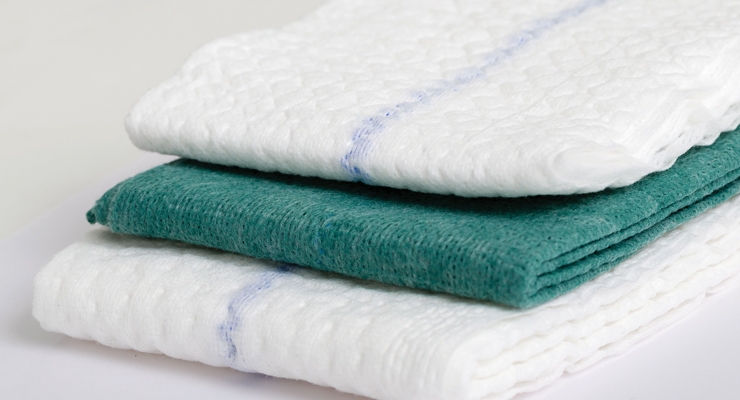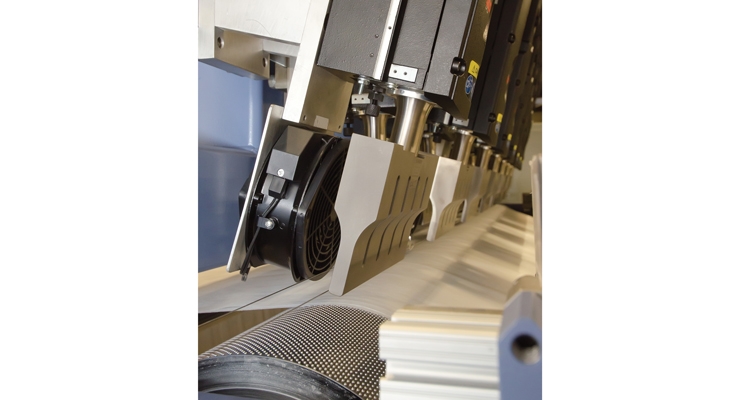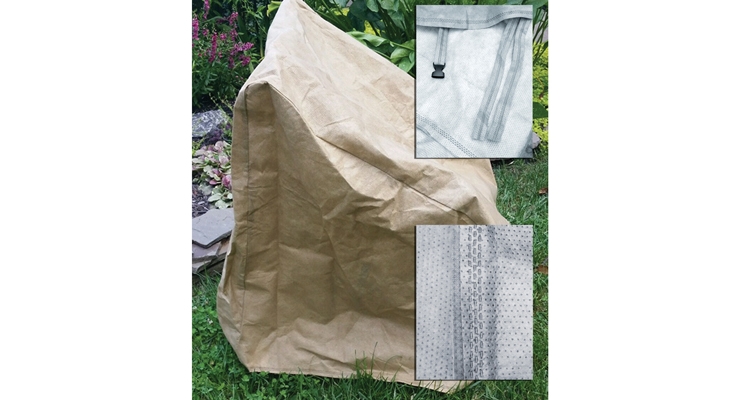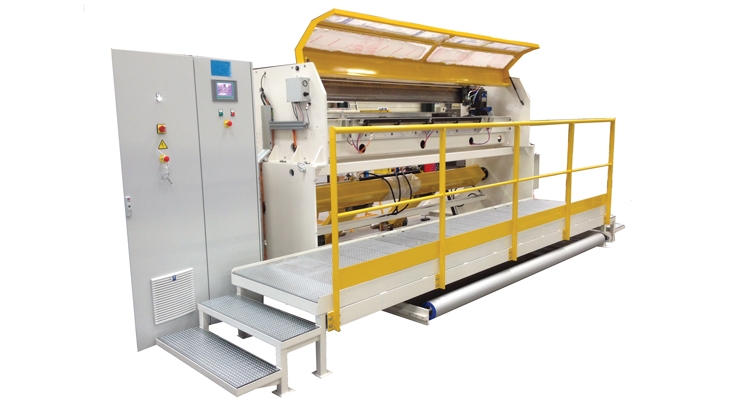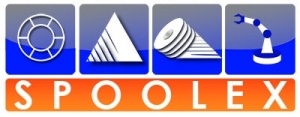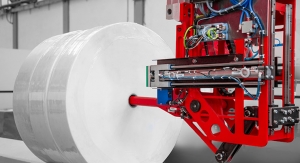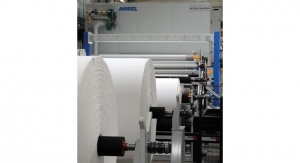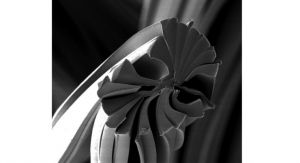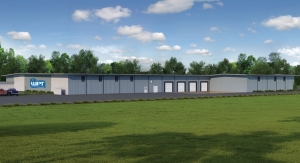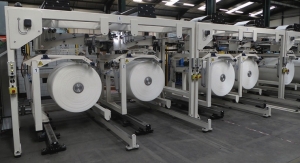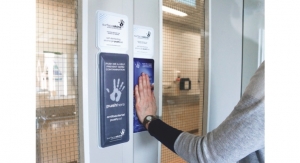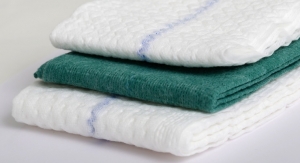Tara Olivo, Associate Editor01.05.18
Ultrasonic technology is increasingly being used across various sectors of the nonwovens industry, including absorbent hygiene products, filtration, automotive applications, the cable industries and more. In general terms, ultrasonic bonding uses high frequency sound to generate localized heat through vibration and causes thermoplastic fibers to bond together. This technology is sometimes able to replace other bonding methods such as adhesive and thermal technologies in certain applications. Following is a look at what some of the key manufacturers of ultrasonic technology are innovating in the nonwovens industry.
Chase Sees Growth in Filtration
Chase Machine and Engineering manufactures custom web handling equipment for a wide range of customers in the medical, nonwoven, converting, geotextile, extrusion, filtration and packaging industries. The company built its first ultrasonic slitter for the hook and loop industry in the late 1970s.
“It was at that point in time we realized that ultrasonic technology offered end users tremendous benefits,” says Guy Gil, president, Chase Machine and Engineering.
Since then, Chase Machine and Engineering has built ultrasonic laminators, embossers, slitters, cut to lengths and splicing equipment ranging from nine to 144 inches wide. This equipment can be used in nearly every industry in which nonwovens are used.
Over the years, Gil has seen the use of ultrasonics for nonwoven lamination, slitting and splicing grow within the filtration and medical industries. “As manufacturers of nonwovens continue to improve their product, end users find more applications and quite often select ultrasonics to assemble those materials,” he says.
Ultrasonics offers advantages over other bonding technologies because it’s a clean and efficient method of joining or slitting synthetic materials. “While the initial investment is much more, the long term benefits more than pay for itself,” Gil explains. “Thermal methods such as hot oil or electrically heated systems require an initial preheat cycle in order to bring the tooling to operating temperature. Then, while running, there is a significant amount of heat loss.”
On the other hand, ultrasonic technology is instantaneous, he says. “The operator can start and stop the equipment without worrying about melting the materials being processed. It is also a very clean method of laminating as there are no hoses or rotary unions that may leak over time.”
Most recently, Gil has seen ultrasonics gain ground with manufacturers of filtration products, since they are commonly assembled using adhesives or needle and thread. “The primary driver to find alternative methods has to do with cost and quality,” he continues. “Adhesives are expensive and sewing leaves holes in the product. Ultrasonics fuse the nonwoven materials to create a hermetic seal which is much better than applying an adhesive or seam tape over a sewn seam.”
Herrmann Develops Technology for Abdominal Swabs
Karlsbad, Germany-based Herrmann Ultrasonics, which supplies ultrasonic bonding technology to machinery builders and end users, recently developed a new and automated ultrasonic assembly line—with complete ultrasonic laminating and sealing steps—for a new and patented abdominal swab called texart by Portuguese medical producer Bastos Viegas.
Previously a complex sewing process with ample manual handling steps was used to produce the swab, according to Herrmann. The new swab enables automated roll-to-finished-products assembly. This latest material configuration developed and patented by Bastos Viegas is made of three layers, using woven and nonwoven technology. A textile net in the middle—made of polyamide/polyester—with an x-ray thread is placed between two layers of spunlace nonwoven (70% viscose and 30% polyester). The wrinkled surface of texart increases the absorption rate and produces a soft sponge-like feeling.
According to Markus Pasternak, regional sales director Nonwovens for Herrmann, the sonotrode design and new special coatings have allowed Herrmann to solve new applications like the abdominal swab. “Bastos Viegas, one of the biggest suppliers of non active medical devices in Europe, has been using ultrasonic technologies for a long time,” he says. “Not adding any additional material to their product gives ultrasonic technology a leg up and makes it so successful for medical applications like this.”
Herrmann is always developing new ultrasonic systems, Pasternak says. A recent development from the company for continuous applications is a high power generator for the Ultrabond 48.20. The digital ultrasonic generator technology of the Ultrabond product line is specifically designed for continuous weld processes with continuous power ranges of up to 8000 W. A DSP (Digital Signal Processor) compensates for fault effects and ensures repeatable ultrasonic output at a duty cycle of 100%. Next up on the market for Herrmann will be a completely new Microbond control system that allows the customer to visualize the ultrasonic process and understand it even more.
Pasternak continues to see interest in ultrasonic applications grow, with the highest interest still coming from hygiene applications. New applications such as ears, elastic laminations and constructions, ADL, core and more, are developed and tested at Herrmann’s four headquarters in Germany, the U.S., China and Japan. In nonwovens manufacturing, filtration, automotive and other industries, Pasternak says ultrasonics proves to have a lot of benefits. “It is so interesting that material suppliers are adapting their recipes to produce and create more ultrasonic suitable materials,” he concludes.
Sonobond Promotes Technology for Outdoor-Use Protective Coverings
Sonobond Ultrasonics offers plunge welders, rotary welders, rotary cutters and hand cutters as part of its portfolio of ultrasonic technology. The company can also make new custom tooling to best handle new applications.
According to president Janet Devine, Ultrasonics, growth for ultrasonics has been consistent with the expanded use of nonwovens, especially in 2017. In particular, the company has seen substantial growing interest in the ultrasonic bonding of materials with a laminated backing of nonwoven material for use in the medical/hygiene industry. These products include covers for mattresses and wheelchair cushions, as well as medical devices and instruments.
There are number of benefits that ultrasonics provide over other bonding methods, Devine says, but the most important advantage is the ability to seal materials without making holes in the fabric. “Especially where the fabric is water resistant this can prevent liquids from penetrating or leaking through the product seams,” she says.
With Sonobond technology, seams can be bonded and trimmed with its rotary system in a single pass. Additionally ultrasonic bonding or cutting is faster and often cheaper than sewing or gluing. “Cutting with ultrasonics offers the advantage of sealing the edges of the material as they are cut,” she explains.
Recently, Sonobond has been promoting the use of ultrasonics for outdoor-use protective coverings, where ultrasonic leak-free seaming has contributed to the enduring quality, effectiveness and success of products that are left outdoors. Manufacturers are using ultrasonic technology for coverings made for automotives such as cars, RVs, motorcycles and boats; outdoor furniture covers and cushion liners; barbecue grill covers; and protective envelopes for product shipments.
Sonobond technology can ultrasonically bond fabrics that are 100% synthetic or fabric blends with up to 40% natural fibers, according to company vice president Melissa Alleman.
Sonobond offers two types of ultrasonic bonding units specifically applicable for assembling protective coverings. Though similar in appearance and operation to a traditional sewing machine, Sonobond’s SeamMaster High Profile Ultrasonic Sewing Machine has a high clearance between the wheel and horn, allowing increased access for hand-guided applications with curves and tight tolerances. The unit can seam, trim and seal in one step, and offers a wide selection of interchangeable pattern rollers that also hem, emboss and print. The machine requires minimal training to operate and by combining several operations into just one pass, it saves labor, time and money. It is also available as a modular unit that can be integrated into production lines.
For bulky, large, multiple-layer and/or difficult-to-bond materials, Sonobond offers the SureWeld 20 Ultrasonic PlungeBonder. A combination of a rugged welding press and heavy-duty power supply, the welding horns and nests or fixtures of this unit can be customized, allowing it to achieve customers’ specific applications with superior repeatable performance.
Spoolex Offers Range of Technologies
Spoolex, a manufacturer of web converting equipment, designs and manufactures ultrasonic technology under its Calemard and Decoup+ brands. The company launched its first range of ultrasonic devices in 1975.
Spoolex’s manual devices, working station and slitting heads for integration on existing machines are generally developed by Decoup+, while its splicing solutions in line or off-line are made by Calemard. Calemard also offers its slitter-rewinder equipped with ultrasonic slitting heads from Decoup+ technology.
For hygiene applications, Spoolex offers ultrasonic splicing benches/modules to be installed inline to join two webs of nonwoven materials before slitting and rewinding or spooling operations for longer length of product on a single pad or spool. These modules are available as a semi-automatic or fully automatic operation. Ultrasonic splicing benches/modules can be installed off-line to join two large webs of nonwoven materials. Ultrasonic slitting heads can be installed on a slitter rewinder for tapes with resistant, soft and clean sealed edges. Spoolex can also provide an individual ultrasonic welding station for “stitching” operations without any additional material.
“Ultrasonic technology is well adapted to filtration, hygiene, cable industries and airbag production, for example, as it performs strong, invisible and reliable plain splices, without external elements such as glue, adhesive, needle and thread,” according to Pierre Croutelle, sales manager - Textiles & Nonwovens Division, Spoolex.
Chase Sees Growth in Filtration
Chase Machine and Engineering manufactures custom web handling equipment for a wide range of customers in the medical, nonwoven, converting, geotextile, extrusion, filtration and packaging industries. The company built its first ultrasonic slitter for the hook and loop industry in the late 1970s.
“It was at that point in time we realized that ultrasonic technology offered end users tremendous benefits,” says Guy Gil, president, Chase Machine and Engineering.
Since then, Chase Machine and Engineering has built ultrasonic laminators, embossers, slitters, cut to lengths and splicing equipment ranging from nine to 144 inches wide. This equipment can be used in nearly every industry in which nonwovens are used.
Over the years, Gil has seen the use of ultrasonics for nonwoven lamination, slitting and splicing grow within the filtration and medical industries. “As manufacturers of nonwovens continue to improve their product, end users find more applications and quite often select ultrasonics to assemble those materials,” he says.
Ultrasonics offers advantages over other bonding technologies because it’s a clean and efficient method of joining or slitting synthetic materials. “While the initial investment is much more, the long term benefits more than pay for itself,” Gil explains. “Thermal methods such as hot oil or electrically heated systems require an initial preheat cycle in order to bring the tooling to operating temperature. Then, while running, there is a significant amount of heat loss.”
On the other hand, ultrasonic technology is instantaneous, he says. “The operator can start and stop the equipment without worrying about melting the materials being processed. It is also a very clean method of laminating as there are no hoses or rotary unions that may leak over time.”
Most recently, Gil has seen ultrasonics gain ground with manufacturers of filtration products, since they are commonly assembled using adhesives or needle and thread. “The primary driver to find alternative methods has to do with cost and quality,” he continues. “Adhesives are expensive and sewing leaves holes in the product. Ultrasonics fuse the nonwoven materials to create a hermetic seal which is much better than applying an adhesive or seam tape over a sewn seam.”
Herrmann Develops Technology for Abdominal Swabs
Karlsbad, Germany-based Herrmann Ultrasonics, which supplies ultrasonic bonding technology to machinery builders and end users, recently developed a new and automated ultrasonic assembly line—with complete ultrasonic laminating and sealing steps—for a new and patented abdominal swab called texart by Portuguese medical producer Bastos Viegas.
Previously a complex sewing process with ample manual handling steps was used to produce the swab, according to Herrmann. The new swab enables automated roll-to-finished-products assembly. This latest material configuration developed and patented by Bastos Viegas is made of three layers, using woven and nonwoven technology. A textile net in the middle—made of polyamide/polyester—with an x-ray thread is placed between two layers of spunlace nonwoven (70% viscose and 30% polyester). The wrinkled surface of texart increases the absorption rate and produces a soft sponge-like feeling.
According to Markus Pasternak, regional sales director Nonwovens for Herrmann, the sonotrode design and new special coatings have allowed Herrmann to solve new applications like the abdominal swab. “Bastos Viegas, one of the biggest suppliers of non active medical devices in Europe, has been using ultrasonic technologies for a long time,” he says. “Not adding any additional material to their product gives ultrasonic technology a leg up and makes it so successful for medical applications like this.”
Herrmann is always developing new ultrasonic systems, Pasternak says. A recent development from the company for continuous applications is a high power generator for the Ultrabond 48.20. The digital ultrasonic generator technology of the Ultrabond product line is specifically designed for continuous weld processes with continuous power ranges of up to 8000 W. A DSP (Digital Signal Processor) compensates for fault effects and ensures repeatable ultrasonic output at a duty cycle of 100%. Next up on the market for Herrmann will be a completely new Microbond control system that allows the customer to visualize the ultrasonic process and understand it even more.
Pasternak continues to see interest in ultrasonic applications grow, with the highest interest still coming from hygiene applications. New applications such as ears, elastic laminations and constructions, ADL, core and more, are developed and tested at Herrmann’s four headquarters in Germany, the U.S., China and Japan. In nonwovens manufacturing, filtration, automotive and other industries, Pasternak says ultrasonics proves to have a lot of benefits. “It is so interesting that material suppliers are adapting their recipes to produce and create more ultrasonic suitable materials,” he concludes.
Sonobond Promotes Technology for Outdoor-Use Protective Coverings
Sonobond Ultrasonics offers plunge welders, rotary welders, rotary cutters and hand cutters as part of its portfolio of ultrasonic technology. The company can also make new custom tooling to best handle new applications.
According to president Janet Devine, Ultrasonics, growth for ultrasonics has been consistent with the expanded use of nonwovens, especially in 2017. In particular, the company has seen substantial growing interest in the ultrasonic bonding of materials with a laminated backing of nonwoven material for use in the medical/hygiene industry. These products include covers for mattresses and wheelchair cushions, as well as medical devices and instruments.
There are number of benefits that ultrasonics provide over other bonding methods, Devine says, but the most important advantage is the ability to seal materials without making holes in the fabric. “Especially where the fabric is water resistant this can prevent liquids from penetrating or leaking through the product seams,” she says.
With Sonobond technology, seams can be bonded and trimmed with its rotary system in a single pass. Additionally ultrasonic bonding or cutting is faster and often cheaper than sewing or gluing. “Cutting with ultrasonics offers the advantage of sealing the edges of the material as they are cut,” she explains.
Recently, Sonobond has been promoting the use of ultrasonics for outdoor-use protective coverings, where ultrasonic leak-free seaming has contributed to the enduring quality, effectiveness and success of products that are left outdoors. Manufacturers are using ultrasonic technology for coverings made for automotives such as cars, RVs, motorcycles and boats; outdoor furniture covers and cushion liners; barbecue grill covers; and protective envelopes for product shipments.
Sonobond technology can ultrasonically bond fabrics that are 100% synthetic or fabric blends with up to 40% natural fibers, according to company vice president Melissa Alleman.
Sonobond offers two types of ultrasonic bonding units specifically applicable for assembling protective coverings. Though similar in appearance and operation to a traditional sewing machine, Sonobond’s SeamMaster High Profile Ultrasonic Sewing Machine has a high clearance between the wheel and horn, allowing increased access for hand-guided applications with curves and tight tolerances. The unit can seam, trim and seal in one step, and offers a wide selection of interchangeable pattern rollers that also hem, emboss and print. The machine requires minimal training to operate and by combining several operations into just one pass, it saves labor, time and money. It is also available as a modular unit that can be integrated into production lines.
For bulky, large, multiple-layer and/or difficult-to-bond materials, Sonobond offers the SureWeld 20 Ultrasonic PlungeBonder. A combination of a rugged welding press and heavy-duty power supply, the welding horns and nests or fixtures of this unit can be customized, allowing it to achieve customers’ specific applications with superior repeatable performance.
Spoolex Offers Range of Technologies
Spoolex, a manufacturer of web converting equipment, designs and manufactures ultrasonic technology under its Calemard and Decoup+ brands. The company launched its first range of ultrasonic devices in 1975.
Spoolex’s manual devices, working station and slitting heads for integration on existing machines are generally developed by Decoup+, while its splicing solutions in line or off-line are made by Calemard. Calemard also offers its slitter-rewinder equipped with ultrasonic slitting heads from Decoup+ technology.
For hygiene applications, Spoolex offers ultrasonic splicing benches/modules to be installed inline to join two webs of nonwoven materials before slitting and rewinding or spooling operations for longer length of product on a single pad or spool. These modules are available as a semi-automatic or fully automatic operation. Ultrasonic splicing benches/modules can be installed off-line to join two large webs of nonwoven materials. Ultrasonic slitting heads can be installed on a slitter rewinder for tapes with resistant, soft and clean sealed edges. Spoolex can also provide an individual ultrasonic welding station for “stitching” operations without any additional material.
“Ultrasonic technology is well adapted to filtration, hygiene, cable industries and airbag production, for example, as it performs strong, invisible and reliable plain splices, without external elements such as glue, adhesive, needle and thread,” according to Pierre Croutelle, sales manager - Textiles & Nonwovens Division, Spoolex.

